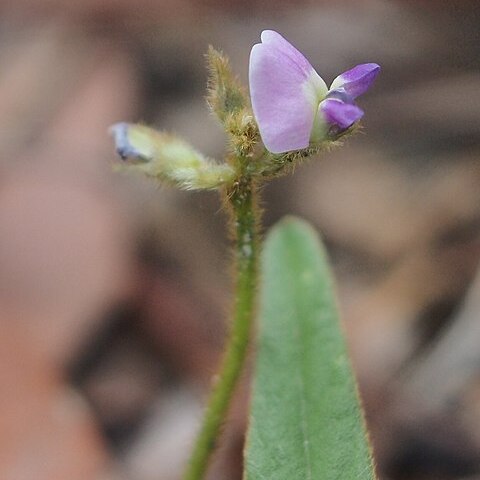Herbs annual. Stems robust, twining or climbing, base many branched, yellowish brown villous. Leaves pinnately 3-foliolate; stipules ovate-lanceolate, 2.5-3 mm, yellow-brown tomentose; petiole ca. 1.5 cm; stipels lanceolate; leaflets papery, elliptic or ovate, 1.5-2.5 × 1-1.5 cm, abaxial surface sparsely hairy, adaxial surface densely yellow-brown tomentose, lateral veins 5 pairs, base rounded, apex obtuse-rounded, mucronate. Raceme 3-7 cm, yellowish brown villous; peduncle ca. 4 cm; bracts lanceolate; flowers solitary or 2-7(-9) clustered at top. Flowers ca. 10 mm; pedicel ca. 1 mm; bracteoles linear. Calyx campanulate, membranous, ca. 4 mm, densely pubescent; lobes 5, narrowly triangular, longer than or subequal to tube. Corolla reddish, puniceous, or purple; standard large; wings and keels smaller, clawed. Ovary with short stipe. Legume narrowly oblong, compressed, straight, dehiscent, 18-22 × 4-5 mm, yellow-brown villous; neck short. Seeds 1-4, dark brown, oblate-tetragonal, ca. 2 × 2 mm; testa with minipores and granular nodules. Fl. Jul-Aug, fr. Sep-Oct. 2n = 38, 40, 78, 80.
More
A herb with long trailing or twining stems. The stems can be covered with rusty hairs. The stems can be 1 m long and have a thick rootstock. The leaves have 3 leaflets. The leaflets are oblong and up to 6 cm long by 3.5 cm wide. They taper to a blunt tip and are rounded at the base. They are hairy on both surfaces. The flower clusters are 9 cm long and in the axils of leaves. The flowers are pea shaped and 6-7 mm long. The wing is usually red or blue. The fruit are thin pods. They are 1.8-2.8 cm long and 3-4 mm wide. They are constricted between the seeds. They split open into 2 halves. There can be 6 seeds inside.

